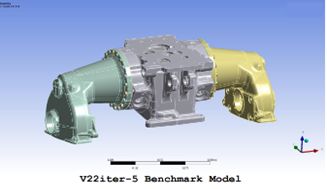-
United States -
United Kingdom -
India -
France -
Deutschland -
Italia -
日本 -
대한민국 -
中国 -
台灣
-
Ansys stellt Studierenden auf dem Weg zum Erfolg die Simulationssoftware kostenlos zur Verfügung.
-
Ansys stellt Studierenden auf dem Weg zum Erfolg die Simulationssoftware kostenlos zur Verfügung.
-
Ansys stellt Studierenden auf dem Weg zum Erfolg die Simulationssoftware kostenlos zur Verfügung.
-
Kontakt -
Karriere -
Studierende und Akademiker*innen -
Für die Vereinigten Staaten und Kanada
+1 844,462 6797

Moving all your computing activities to the cloud can be challenging. Instead, choose the environment that best meets your needs and make accessing the cloud easy for engineering teams. Use tools such as Ansys Gateway powered by AWS software, which offers a flexible, cost-effective option for using Ansys Mechanical structural finite element analysis (FEA) software.
Faced with large problem sizes and urgent deadlines, it’s not surprising that more and more product development teams are accessing high-performance computing (HPC) resources on the cloud. After all, a cloud computing model enables you to access the most advanced, leading-edge software and hardware on demand. There are no queues or wait times. Users can “dial up” core counts and other settings to run simulation quickly if they’re facing critical project milestones. Additionally, companies can avoid the upfront investments, in-house IT staffing, and long-term maintenance costs associated with on-premises HPC clusters.
However, the move to a cloud computing model isn’t always easy, as transformations that involve both technological and cultural shifts rarely are. Engineers and other product development stakeholders need to change some aspects of the practices and workflows they’ve become accustomed to. IT investments must shift from building and maintaining internal resources to paying licensing fees and trusting a third party. And there’s always going to be some pushback in the form of questions like, “Why aren’t we using the computing resources we’ve already invested in?” In the quest to reduce the time to solve, ensure costs aren't too high, and make simulation available on demand from anywhere at any time, a one-size-fits-all solution may not suit all customers. Additionally, we have found that the best approach is likely to carefully trigger compute needs and scale up or down using a hybrid cloud approach, combining on-premises performance for usual needs and cloud resources for peak demand.
In our work with customers across industries like MPR Associates, Ansys has seen firsthand the hurdles that engineers must overcome to accelerate their solution times via cloud resources. Fortunately, we have the perfect answer: Our proprietary cloud platform, Ansys Gateway powered by AWS software, can be used as a flexible, on-demand resource to help overcome short-term computing roadblocks like especially large problem sizes, tight deadlines, and long internal queues without a complete transition to the cloud. Ansys Gateway powered by AWS software supports an innovative “hybrid” HPC approach that complements your internal computing cluster with powerful cloud resources — but only when you need them.
This “plug-and-play” cloud platform, developed by Ansys and Amazon Web Services (AWS), is perfectly configured for the needs of simulation users. It’s an elastic HPC resource that can be turned on or off as your computing needs change over time, without the need to pay a fixed licensing fee. And it replicates the performance of a six-figure HPC internal hardware stack, without the need to invest upfront and then pay for staffing and maintenance.
Growing Problem Sizes: A Product Development Challenge
We’ve made a case for using this hybrid HPC model in our new white paper, “Cloud vs. On-premises? Ansys Gateway powered by AWS Enables a Hybrid Approach to Optimize Total Cost of Ownership (TCO).” Based on an internal Ansys study, this white paper compares the cost and time-to-solution performance of Ansys’ proprietary cloud platform to typical internal HPC clusters.
For the purposes of our study, we looked at a simulation we developed in-house: A relatively straightforward, non-transient simulation of a rear axle housing for a tractor. At one time, all of us probably considered a “large” simulation to be one focused on a complex product, like a rocket or a jet. But, as more engineering teams apply multiple physics and use extremely accurate, high-fidelity tools, even everyday simulations have become computationally large and unwieldy. The tractor axle model in our study, for example, uses the PCG solver in Ansys Mechanical structural FEA analysis software and requires 170 GB of RAM for 64 CPU cores. This exceeds the capabilities of most in-house desktop and workstation computers.

This rear axle of a tractor is a 3.8 GB model with 63 million degrees of freedom that was used in an internal Ansys study. It was chosen because it is representative of customers’ large models and nonproprietary.
In the Ansys study, our experts solved this problem iteratively, using both internal clusters and Ansys Gateway powered by AWS. Ansys experts changed the HPC settings and configurations — such as the number of computing nodes — to analyze the effects of those alterations. They determined how to maximize time to solution in isolation, as well as cost per job in isolation.
Why did our study look at these factors in isolation? Because every product development team has different concerns. Some companies prioritize keeping costs low, regardless of the time required to complete simulation tasks. Others prioritize achieving the fastest possible solution times, with less concern for the associated costs. These priorities have a huge impact on determining the “optimal” HPC configuration and delivery model for a given organization.
Our experts also studied how to best balance cost with speed, to address the needs of the majority of Ansys customers, whose computing needs change over time.

For Many Companies, Computing Flexibility Is the Answer
You can download the white paper to read all the details, but the Ansys study had one clear finding. For the typical engineering team with changing computing demands, a hybrid approach simply makes good business sense from both a time and cost perspective. Product development teams can enjoy endless speed and bandwidth when they need it, without the need to pay thousands of dollars for hardware and associated cluster management costs.
But don’t take our word for it. Many Ansys customers are already leveraging the benefits of a hybrid, flexible approach in which their internal HPC resources are supplemented by running their workloads in the cloud. While many product development teams struggle with how to add more computing power, speed, and capacity for their large or time-sensitive simulations, companies that have embraced using the cloud enjoy faster time to solution and better resource utilization. Furthermore, companies that use a tool such as Ansys Gateway powered by AWS software minimize the effort required to familiarize engineers with running simulation on AWS.
For example, energy company Turntide Technologies has achieved a 7X improvement in speed, without incurring significant added costs, by using Ansys Gateway powered by AWS software for simulations that are especially large in scale, timely in nature, or both. Emirates Team New Zealand, an America’s Cup yacht racing team, accelerates its design cycle and spurs innovation by using AWS for some of its large problems, including meshes that exceed 50 million cells. When Engineering consultants at MPR Associates confront a long wait time for their internal HPC resources, they instead move simulation workloads to AWS avoid delays in turning around client deliverables. At both Emirates Team New Zealand and MPR associates, they choose not to install Ansys software in AWS by themselves, but instead decided to use Ansys Gateway powered by AWS software to minimize the technical effort.
There’s no simple formula for determining the total cost of ownership (TCO) — as well as the break-even point — when comparing cloud and on-premises HPC resources, but every day Ansys customers are demonstrating the proven value of a hybrid approach that relies on both. As product development teams begin to explore cloud computing, their own TCO will become evident, and they can make a more informed, intelligent decision about their use of a cloud platform moving forward.
Ansys can help by looking at the unique characteristics of your computing patterns — such as the number of simulation users, typical problem size, importance of solution speed, availability of capital for investment, importance of launch deadlines, and the peaks and valleys of internal computing usage. The simulation and cloud experts at Ansys can help identify the best solution for your unique needs, whether that means helping you find the right balance between on-premises versus in-cloud or simply helping your team learn how to use Ansys Gateway powered by AWS software.
In the end, Ansys is invested in optimizing your company’s simulation outcomes — no matter what approach is needed. Contact Ansys today and start arriving at your own answer to the “cloud versus on-premises” question.
Just for you. We have some additional resources you may enjoy.
The Advantage Blog
The Ansys Advantage blog, featuring contributions from Ansys and other technology experts, keeps you updated on how Ansys simulation is powering innovation that drives human advancement.













